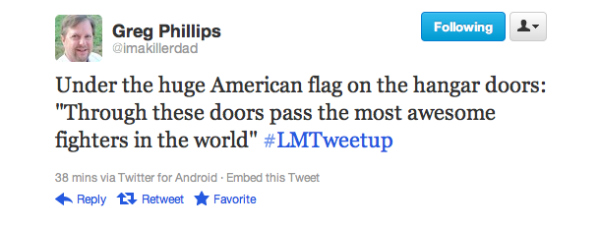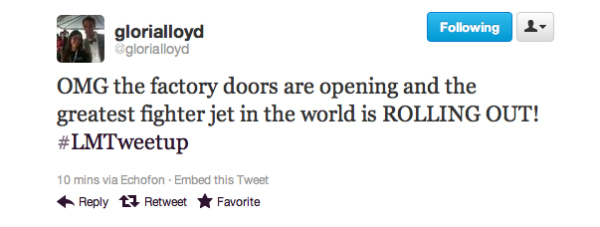Tweetups Then and Now
Lockheed Martin held their first Tweetup this week, inviting fans to see the last F-22 roll out of the factory. So what’s a Tweetup and how did they start?
Last week a handful of lucky aviation fans got a special tour through the Lockheed Martin factory in Marietta, Georgia, to attend the rollout ceremony for the last F-22 Raptor off the production line. The group took part in the company’s first Tweetup, an outreach phenomenon organized via Twitter and popularized by NASA over the past few years.
The Tweetup is an ingenious (sly?) way to accomplish two things: 1) increase goodwill among current supporters — that is, rile up the fan base, and 2) circumvent direct media coverage to get attention. Participants are given behind-the-scenes access to facilities and special events, and usually spend much of it hunched over their smartphones live-tweeting it to their combined thousands (or more) of followers. The infectious, earnest, enthusiasm of a couple of tweets can be more effective than most professional goodwill campaigns.
NASA tracked the outgoing tweets from 150 participants at their August 2011 event to watch the launch of the Juno Jupiter spacecraft from the Kennedy Space Center, and estimated that it resulted in a whopping 29.9 million impressions. Of course, NASA has capitalized on the Tweetup like no other public agency, so we were interested to see the practice expand to the private sector. Aside from ATK, which held a space-related Tweetup for fans to watch a solid rocket test this past September, Lockheed seems to be the first aerospace company to hold an event for ordinary people to get a behind-the-scenes look at a modern fighter jet.
But unlike NASA centers, Lockheed facilities are understandably shrouded in secrecy. In fact, the participants in the Tweetup weren’t allowed to take photos — despite being given free rein to tweet unfiltered details about everything they saw.
Lockheed’s Tweetup organizer Alison Orne told us:
We’ve seen how powerful Tweetups can be in increasing public awareness and engaging audiences in a new and innovative way… We intentionally decided to start small and local with our first Tweetup around the F-22 Final Assembly Rollout ceremony.
That’s probably smart, given that successive Tweetups seem to be exponentially more successful as an organization’s social media fan base grows.
We were curious about the origins of these events, so we asked the person who conceived them as a tool for NASA: Veronica McGregor, Manager for News and Social Media at NASA’s Jet Propulsion Laboratory. (She was also the voice behind the endearing first-person @MarsPhoenix account.) She emails:
Going back to 2008, tweetups were being held in various cities as informal get-togethers of “tweeps” residing in the same geographic location. They usually took place in coffee shops, bars and restaurants. I noticed a few of these going on, and I attended probably the first Los Angeles-area tweetup in late 2008. It was a nice way to meet other people on Twitter, but the get-together wasn’t focused on anything in particular. Everyone split off into smaller groups of 2 to 4 people when they found people who shared similar interests. I remember I found only one person at that tweetup who was remotely interested in space.
From that, the idea occurred to me to hold a tweetup at JPL to bring together like-minded people. I had seen the space community grow (especially with space fans finding each other through the @MarsPhoenix account) and thought it would be a great idea to have them come to JPL to see our missions first-hand and have the opportunity to meet each other. I proposed the tweetup on twitter first, asking how many would be interested and what would be the best day/time (weekend, weekday, daytime or evening, etc.). We got tremendous feedback and organized the first tweetup for an evening in January 2009 for about 120 people. We did pre-registration online and the event was filled in less than 90 minutes. People from around the country (and a few foreign nations) signed up.
McGregor also mentioned the CEO of Zappos came to the first JPL Tweetup; he was impressed enough to start holding them for his own company. Since 2009, other companies like Ford, Disney, and Sea World, not to mention museums and educational institutions like the Smithsonian and even the White House, have embraced this social media tool to get the word out.
It sounds like Lockheed is gearing up for more fan-centric events — maybe if you lobby nicely they’ll let you sit in the Joint Strike Fighter, hmm? Well, maybe not. But perhaps other aviation companies will follow Lockheed’s lead, and open their doors to the tweeting public.

